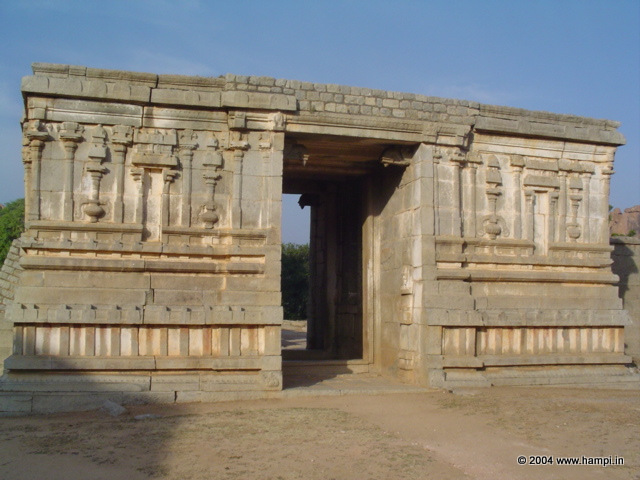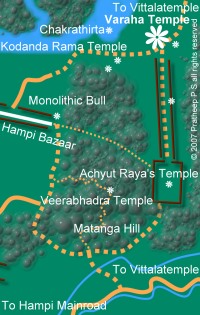Varaha Temple

Y
ou can find the Varaha Temple at the north end of the courtesans’ street, close to the riverside. A typical of Vijayanagara style, the temple is constructed within a rectangular compound (about 40 meters x 20 meters) with an entrance tower. Though still majestic, the top portion of the tower is missing.A few bas-reliefs of boars of boars are carved on to the temple walls. Probably this could have been the source of the temple’s name. The same type of motif can be found as part of the Vijayanagara Empire’s insignia. The rectangular sanctum is located at the middle of the compound. This partially ruined temple is devoid of any idols in its sanctum. The Archeological Survey of India has recently renovated the temple to some extend. You can spot the archeologists’ marks on the rearranged rectangular stone blocks.
In his third incarnation Lord Vishnu takes the form of Varaha (the mythical boar). The purpose of this incarnation was to save the earth from a demon called Hiranyaksha who took it to the bottom of the mythic ocean. The battle that started between the two continued for a thousand years. In iconography Varaha can be seen with the (saved) earth holding between the tusks.
There is also a school of experts who believe that this could be a Shiva temple and not a Varaha temple. The artifacts along with the temple configuration could have been the basis for this theory. Like the case for many presumptions about the Hampi ruins, the authenticity of this is still to be validated.
This east-facing temple is located at the bifurcation of a major riverside path. The trail that connects Kodandarama Temple to the Vittala Temple pass along the southern wall of the Varaha Temple. At this point a branch trail heads southward to the Achutarara Temple. From Varaha Temple you can spot the Rangatha temple just across the path in front and Achuta Raya’s Temple tower at the end of the Courtesans’ Street.

The Varaha image on the temple wall of the Varaha Temple that brought the name. This is the Insignia used by the Vijayanagara kings. The Insignia consist of the boar (varaha), dagger , moon (over the dagger) and the sun (not seen in this image).
The Varaha image on the temple wall of the Varaha Temple that brought the name. This is the Insignia used by the Vijayanagara kings. The Insignia consist of the boar (varaha), dagger , moon (over the dagger) and the sun (not seen in this image).

Varaha Temple pavilion
Varaha Temple pavilion

Varaha Temple Gateway
Varaha Temple Gateway

Location map for Varaha Temple
Location map for Varaha Temple
